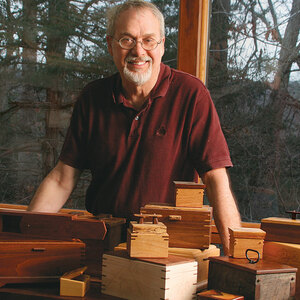Make Short Work of Small Parts
With bench hooks and hand tools, fitting fine pieces is as easy as 1-2-3
Synopsis: One of the easiest and most precise ways to make and fit small parts, such as for boxes and small cabinets, is to use hand tools and three bench jigs. The jigs—a planing stop, a saw hook, and a shooting board—are easy to make, last a long time, and come in handy for a wide range of jobs. The planing stop is particularly useful for surfacing small parts, from miter keys to box lids. The saw hook provides a stable platform for rough-cutting small parts to length. And the shooting board comes in handy for squaring up ends, planing miters, and trimming parts for a perfect fit.
After years of making small boxes with delicate trays and cabinets with small drawers, I’ve found that the safest, fastest, and most precise way to make and fit small parts is with a backsaw, a handplane, and three bench jigs. The jigs—a planing stop, a saw hook, and a shooting board—are easy to make, last a long time, and come in handy for a wide range of jobs.
Each of these jigs is useful by itself, but they really shine when used together. I line them up on my bench and go quickly from one to the next. It makes for a quiet, safe, and efficient workstation. And the fit and finish of my small parts is better than ever.
I’ll show you how to make the jigs—and then how to use them—as I make and fit the parts for a jewelry box.
A planing stop for thin stock
This planing jig provides rock-solid support for handplaning small parts, from miter keys to box lids. The base hooks over the edge of the workbench while the 1⁄8-in.-thick stop prevents the workpiece from sliding. Its low profile won’t interfere with thin stock, and it’s secured with brass screws, which will do less damage if they contact the plane iron. A strip of P220-grit paper on the hardwood hook keeps the jig from sliding sideways. I use high-quality veneer-core plywood for all three jigs, because it stays flat over the long haul.
A versatile saw hook
Like the planing jig, the saw hook is designed to sit on a workbench, providing a stable platform for roughcutting small parts to length—more quickly and safely than a power tool. Instead of a shallow stop, it has a taller fence that holds the workpiece steady. The fence has 90° and 45° kerfs that guide the sawblade. When making the jig, don’t worry too much about getting the saw kerfs perfect. This jig is only meant to get parts close to the right length and angle. For a perfect fit, use a low-angle plane and a shooting board (see next page).
From Fine Woodworking #214
For the full article, download the PDF below:
Fine Woodworking Recommended Products

Jorgensen 6 inch Bar Clamp Set, 4 Pack

Estwing Dead-Blow Mallet























Log in or create an account to post a comment.
Sign up Log in